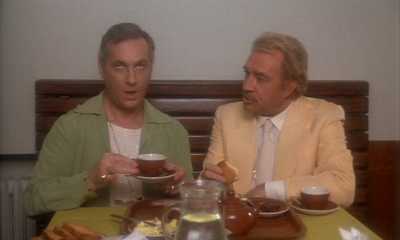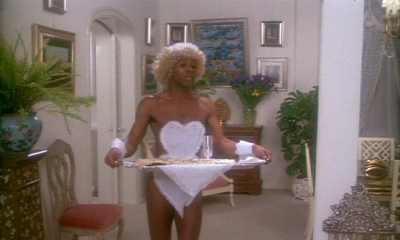Film Review: La Cage aux Folles (1978)
La Cage Aux Folles (1978)
directed by Edouard Molinaro
Frames in this review are taken from the MGM DVD release in 2001.
It's a funny thing, but humor doesn't translate very well across generations. Bob Hope's wisecracks come across today as merely pleasant banter, and many movies thought riotously funny in their day are now merely bizarre. For example, the James Bond spoof Casino Royale is simply incomprehensible).
But La Cage Aux Folles remains humorous today, despite having the additional hurdle of being a Franco-Italian co-production, with the dialog in French and many roles acted by Italians. Admittedly, the film has lost some of its sparkle in the three decades that have passed, and indeed, most films involving homosexuality would probably feel dated today. But that favorite device of situational comedies, the dinner meeting between the parents of young lovers, manages to packs so much misadventure into a short time span that it easily redeems any missteps.

Most of the film is focused on the boy's parents, a pair of gay men living on the French Riviera. Unsurprisingly, they are much more interesting characters than the girl’s uptight parents. They fit relatively neatly into the stereotypical butch-femme roles. Renalto Baldi (Ugo Tognazzi) owns the gay nightclub La Cage Aux Folles. He wears the pants in the relationship and is practically straight, although he does use foundation makeup and his pinky raises reflexively at awkward moments. In contrast, Albin Mugeotte (Michel Serrault), is a stereotypical femme: giggly, fussy, and high-maintenance. He’s better known as Zaza Napoli, the crossdressing star of the nightclub's dance show.
Albin keeps throwing fits about his age and the fact that Renalto never pays attention to him anymore, but the two of them have been together a long time and are used to the routine. Their son, Laurent Baldi (Rémi Laurent) is rosy-cheeked and soft-voiced, the apple of his mother's eye (or rather, his stepfather's). Indeed, the film exploits his appearance to introduce him ambiguously into the picture right after Albin throws a fit and accuses Renalto of cheating on him.
The young girl Louise Charrier (Carmen Scarpitta) is similarly delicate and tentative. How did these two Type B personalities ever get up enough gumption to decide to get married? She doesn't take after either of her parents. Her mother Andrea (Luisa Maneri) is a prim woman who hides her beauty with very drab hairstyles. Her father Simon (Michel Galabru) is the leader of the conservative family-values political party and is prone to frequent fits of apoplexy. Like all French political parties, there’s no question what this one stands for: the Union for Moral Order. There's just one problem: their incumbent President just died suddenly, in the company of an underaged black prostitute.
In the midst of this scandal, Simon is reduced to crawling through the window to avoid the photographers gathered outside the front door, Andrea has a brilliant idea: put on a white-lace-and-flowers church marriage for their daughter to put the party’s troubles behind them. So off they go to the Mediterranean, and finally the real fun begins. After all, the gay jokes can only last for so long and are not as funny as they might’ve been in less-enlightened times.

The upcoming clash between moralists and flamboyant homosexuals provides a more juicy target for inspired humor. The Baldis reside in an apartment upstairs from the nightclub, and it is an improbably ostentatious celebration of (homo-)sexuality. There are vases shaped like buttocks, sculptures of naked Greek athletes, even figurines with erect penises. To top it all off, their maid Jacob (Benny Luke) is a gay Black man who preens around the house without ever wearing enough to be decent, and is given to self-pleasing wordplay like calling Laurent "the little white master."
The only way in which the Baldis can stand a chance against the uptight Charriers is to put on a charade, switching out all the gay artwork for madonnas and Christ on the Cross. Louise has told her parents that Renalto is the cultural attaché at the Italian Embassy. That's a start, but they still need to go further. To fill the role of the adoring housewife, Renalto has to dig up Laurent's mother Simone (Claire Maurier). The president of a local company, she feels a little guilty for abandoning Laurent and is agreeable to the ruse. But she still hasn’t lost her earlier craving for Renalto, and Albin is oh-so-prone to fits of jealousy and is convinced that he'll make a great housewife. Meanwhile, the paparazzi photographers are tipped off about the Charriers’ whereabouts, and they salivate at the chance to take a photo of the leader of the Union for Moral Order coming out of a gay nightclub ...
Suffice it to say that the dinner scene alone makes the film worth watching. In one evening, all the story threads get tied together – and then fall apart. Incidents and accidents happen in rapid succession, and the film manages to surprise the viewer even when the anticipated calamities take place, or don’t.

Without the dinner scene, La Cage aux Folles becomes a rather ordinary film, albeit with some inspired chuckles. At least one of these owes itself to Ennio Morricone's music. Playfully jaunty for most of the film, it borrows liberally from his spaghetti Western scores in a bar scene where Renalto confronts some patrons who are mocking Albin's gayness. Michel Serrault plays Albin with flamboyance, preening and fretting like the queen that he is, and Benny Luke extracts similar mileage out of Jacob. Tognazzi and Galabru likewise do fine character acting as Renalto and Simon, even with Tognazzi clearly dubbed. But the young lovers Laurent and Louise do not make much of an impression. It's hard enough to play indecisive characters in a way that makes it worth watching, but it's made more distracting by the off-sync dubbing job that Louise gets.
In other technical areas, the film is also a mixed bag. The art direction and costumes are very good, especially in the imaginative furnishings and sharp nightclub costumes. But the editing feels off, and it's not entirely the fault of the editors. Apart from the very standard angles, it's apparent from the longer takes that camera movement and framing was not done with much finesse. Humor often depends on split-second precision, and although the editors have picked the right places to cut, the cinematography hasn't always handed them the right angles to cut to. No medium-long shot available? Oh well, let's use a long shot instead. Does the single camera pan away from the character just where a two-camera reaction cut would fit? Oh well, let's just use the pan, because we don’t have anything better. Not a very high-budget production, and it shows.
Even in its afterlife, the MGM La Cage Aux Folles DVD shows signs of a rush job, with a mediocre transfer and poorly balanced colors. But as you may have guessed, this is not a film to be seen for its technical excellence. Think Airplane!: rather slapdash technically, but actually quite funny.